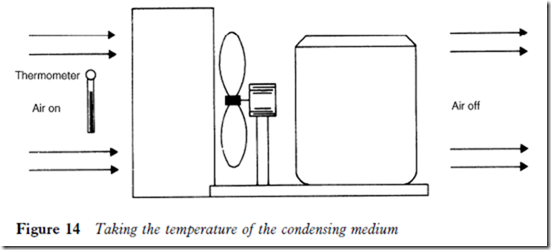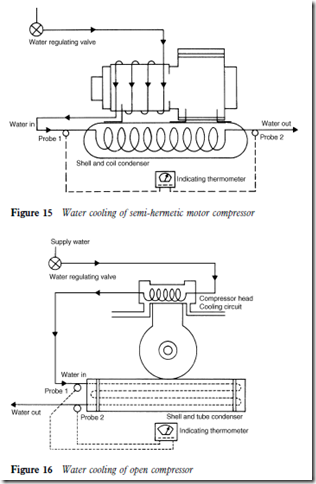Calculating the operating head pressure
Manufacturers of refrigeration condensing units will supply technical data for their products on demand, but this will be based on ideal operating conditions in controlled ambient temperatures. The service engineer or technician, dealing with many different types of equipment, needs a simple quick method to enable him to determine the theoretical operating head pressure of a plant so that this can be compared with the actual operating pressure to assist in fault diagnosis.
It is known that a shortage of refrigerant will produce a low suction pressure, and the fact that the compressor is doing very little work in handling vapour at a lower density will affect the pressure ratio of the compressor.
A restricted supply of refrigerant to the evaporator will not affect the operating head pressure so dramatically as an acute shortage of refrigerant, because there will be a higher pressure existing in the high side of the system, which now contains almost all of the refrigerant charge in the condenser and the receiver. It is therefore possible that only a slightly lower pressure than that to be expected will be registered in the pressure gauge.
The main factor which determines the operating head pressure of a plant is the temperature of the condensing medium, which is the air passing over an air cooled condenser or the water in a water cooled system. It is important that the temperature of the condensing medium be taken accurately and from the correct location. For an air cooled unit this will be the air on to the condenser and not the air off, because the condenser will have rejected heat to the air passing over the condenser coils (see Figure 14).
A simple rule of thumb for calculating the operating head pressure of a refrigeration system is as follows:
1 Hold a thermometer in the air stream to the condenser for 2 to 3 minutes and then note the temperature.
2 Add a condensing factor of 15 °C (30 °F) to this temperature and then convert it to pressure by using a refrigerant comparator or a pressure/temperature graph, or by direct conversion from the pressure gauge on the manifold.
This will be an approximate theoretical head pressure, within 0.7 to 1 bar or 15 psig of that found under the conditions the plant is operating.
An excessively high operating pressure is an indication of a condensing problem; insufficient heat is being rejected by the condenser.
When taking the temperature of the water passing through a water cooled condenser, ensure that the temperature is that of the water actually entering the condenser.
Some semi-hermetic motor compressors are fitted with a water coil for compressor cooling. The supply water passes through this coil before it enters the condenser coil or tubes (see Figure 15).
Some reciprocating open-type compressors used with water cooled systems incorporate a cylinder head cooling feature in the form of a water circuit through the compressor head. Supply water enters this before entering the condenser (see Figure 16).
A rapid indicating thermometer is recommended for taking water temperatures because the water regulating valve responds to the operating head pressure and will vary the temperature of the water as it modulates. It is also necessary, when adjusting the water regulator, to be able to take inlet and outlet temperatures quickly. Locate the thermometer probes tightly to the pipework to ensure good thermal conductivity, note the average inlet temper- ature and calculate as previously described.
To ensure an economical and adequate water flow through a water cooled condenser, the water regulating valve should be adjusted to provide a temperature difference of 15 to 18 °F or 7 to 9 °C between the inlet and outlet of the condenser.
The thermometer probes should be located as indicated in Figures 15 and 16.
Some examples of head pressure calculations follow. The condensing factors used are 15 °C and 30 °F.
Example
An air cooled condensing unit charged with refrigerant R502 operates with the air on to the condenser at 20 °C. Then 20 C 15 D 35 °C: R502 at 35 °C will register a pressure of 13.8 bar.
If the temperature of the air was lower at 15 °C, then 15 C 15 D 30 °C: R502 at 30 °C will register a pressure of 12.2 bar.
A water cooled condensing unit charged with refrigerant R12 operates with water entering the condenser at 50 °F. Then 50 C 30 D 80 °F: R12 at 80 °F will register a pressure of 98 psig.
If the temperature of the water is higher at 65 °F, then 65 C 30 D 95 °F: R12 at 95 °F will register a pressure of 115 psig.

